Breakfast in Greece
The cradle of Western civilization, democracy, theater, philosophy. And also of the famous Mediterranean diet, a style of nutrition also shared with Spain and Italy. Meals in Greece, are a serious theme, a moment of sharing and union, abundance and celebration of life. Understandably, since it was the ancient Greeks who gave life to the figure of Dionysus (and of the feasts dedicated to him), god of wine, of ecstasy and of the liberation of the senses. A rich and delicious cuisine that boasts a series of tasty dishes such as tzatziki sauce, made with yogurt, garlic, dill and cucumber, eaten with pita or with sesame croutons softened with water and extra virgin olive oil. Think also melitzanosalata, a mousse of oven baked aubergine pulp, boiled potatoes, garlic, lemon juice and extra virgin olive oil. There's also dolma, vine leaf rolls stuffed with rice and spices. Equally rich and multifaceted is the sweet front, with phyllo pastry bundles and famous Greek yogurt, ideal delicacies to end the meal, but also to start the day in the best possible way.
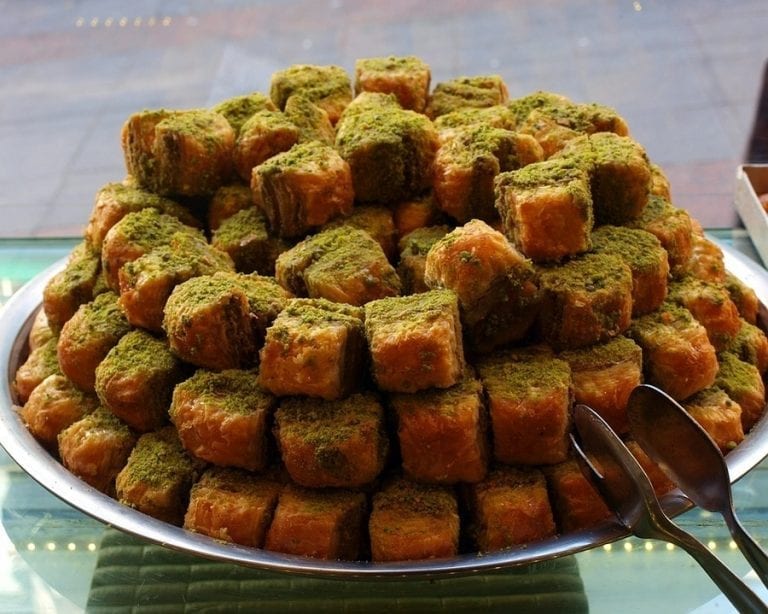
Phyllo pastry tradition
As a base of most of Greek desserts is phillo pastry, a very thin sheet, stretched to the limit, almost transparent, and layered. The realization of the dough is scenographic, and requires great technique and amazing manual skills. A primitive and thicker version comes from Central Asia, where it began to spread as early as the 11th century. First written record of the time is in the "Lughat Diwan al-Turk", a dictionary of Turkish dialects by Mahmud Kashgari, which describes the yuvgha, (from the term yufkla, meaning thin), a type of curled and crispy bread. Phyllo later underwent several changes over the centuries, up to the current leaf-like and thin sheet of paper, most likely born in the kitchens of the Topkapi Palace, once the residence of the Ottoman sultan.
The many shades of Baklava
Different types of desserts are created from the pastry, such as bougatsa, a cake made of very thick phyllo pastry and pastry cream, baked in the oven and dusted with icing sugar. And then the famous baklava, a Turkish sweet born, according to legend, once again at the Topkapi Palace, and soon spread to all areas under the Ottoman Empire, from North Africa to the Middle East, and in almost all kitchens of neighbouring Asia and the Balkans. It''s a pie of buttered pastry, filled with dried fruit, soaked in a solution of sugar and lemon juice or honey and spices. The cake is traditionally cut into lozenges or triangles and served in single portions. Many variations exist: from the Tunisian baklewa, to the Armenian pʼaḫlava up to the Arabic baqlāwa, the Persian baqlavā and again the Albanian bakllava. Precisely this great diffusion of the dessert throughout western Asia and the eastern Mediterranean gave rise to an infinite number of regional variations. In Turkey the key ingredient of the filling are the precious and expensive pistachios from Antep, in Iran the cardamom is added to a mixture of nuts and sugar and the syrup is flavoured with rose water. Armenians add a mixture of peanuts for every three or four layers of filling, while Libyans opt for dates or coconut flakes. Greeks, on the other hand, prefer a simpler version, but no less delicious: honey, walnuts and cinnamon.
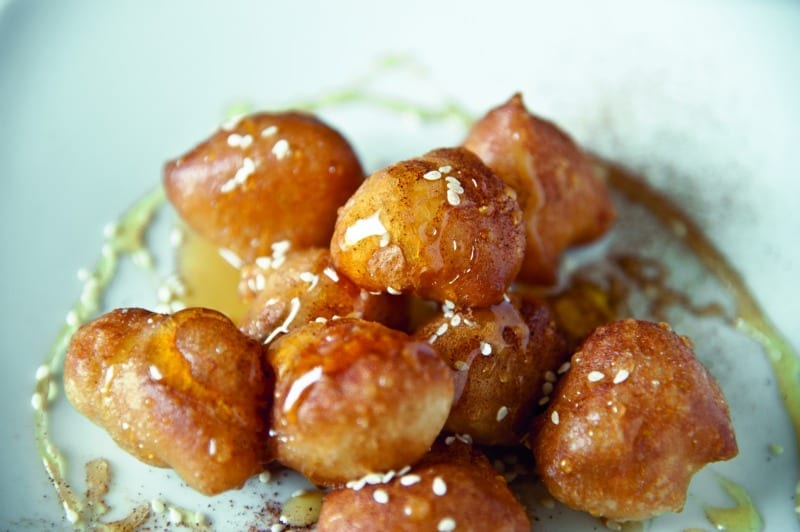
Loukoumade, the prize for athletes
And speaking of honey: another specialty among Greeks breakfast foods is loukoumade, a donut made from flour, water and yeast, fried in sesame oil and seasoned with a honey and cinnamon syrup. A recipe that spanned centuries of history, and that has its roots in ancient Greece, where these sweet donuts represented the athletes' meal. To be precise, the loukoumades make their first appearance during the 776 BC Olympic Games, when the competition consisted only of a running race. Initially called "honey tokens", the fried donuts were the prize of the most deserving winners and athletes, a sort of reward for hard work and commitment. Whether for breakfast or for a mid-morning snack, today there is no coffee bar or bistro that doesn't serve loukoumades, in the traditional version or enriched with fresh fruit, flavoured with a mix of different spices, or stuffed with creams and jams.
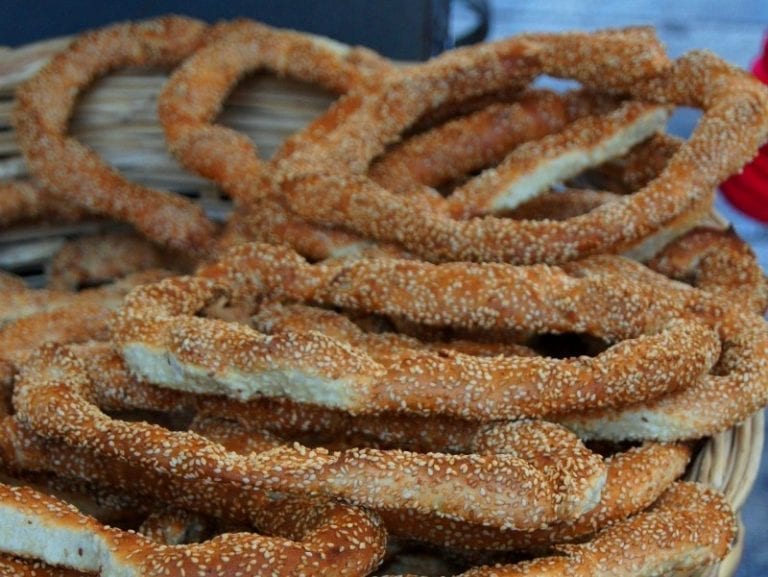
Koulouri, from slave bread to street food
Breakfast now, however, is not always consumed at home or at a coffee bar table. On the contrary, especially in the big cities, it's very common to come across workers and students hurriedly walking with a glass of steaming coffee and a koulouri, the typical bread donut covered with sesame seeds, sold by street artisans located at every street corner. This product derives from the older kollyra, a ring-shaped bread that, due to the low cost of flour, in Ancient Greece was one of the few forms of sustenance for slaves. In Constantinople (now Istanbul), during the Byzantine Empire, this donut was instead the most popular of street foods, but the first written record of the product appeared only in 1593, with the publication of the Üsküdar register, which standardizes its weight and price. Today, koulouri is still one of the most popular street foods in the country, and it's available in many variations, from multigrain to sweet filled with cream, from the tasty stuffed with cheese to the simplest, without sesame seeds, just water, flour and yeast.
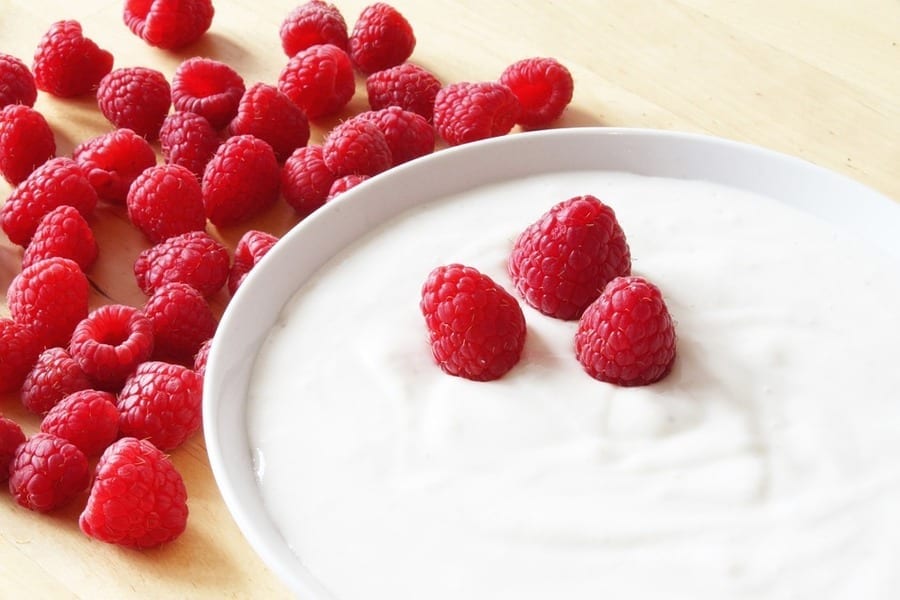
The birth of yogurt
Last but not least, sweet yogurt, among the most appreciated and consumed products in the morning, not only in Greece. A delicious specialty whose origins are lost in the mists of time: the invention of yogurt is in fact attributed by food historians to the populations of the Neolithic of Central Asia, which around 6,000 BC accidentally discovered milk fermentation. Legend has it that the inventor of the product was a shepherd, who for a while forgot about the milk in a leather skin container. On his return, the beverage had changed appearance, becoming more creamy and dense, thanks to the coagulation that took place through the enzymes present in the animal's stomach.
Greek yogurt: features and consumption
What distinguishes Greek yogurt from yogurt from other countries? Texture. Greek yogurt, in fact, is devoid of the liquid part, the whey, is filtered for many hours, and then eliminated. The result is a dense and rich cream, with a flavour similar to traditional yogurt, but with a pleasant extra fattiness, and a greater round touch on the palate. Furthermore, the filtration process not only changes the creaminess of the product, but also some nutritional properties: Greek yogurt, in fact, has lower quantities of lactose, sugars and sodium, and a greater number of proteins. A versatile product that lends itself to sweet and savory recipes, rustic cakes and puddings. There are many ways to consume it in the morning: pure, with a spoonful of honey and some fresh fruit, or with spoon sweet, a fruit preserve boiled in water and sugar, or also with granola, muesli, cereal and a sprinkled with cinnamon.
Recipe: baklava by Laura Ravaioli
In her latest program on Gambero Rosso Channel, "Kasher", Laura Ravaioli shares the secrets Jewish cuisine from Libya, a cuisine that intertwines heterogeneous languages, uses and customs. Here is her version of baklava.
Ingredients
500 g phyllo pastry
250 g margarine, melted
For the filling
400 g assorted ground nuts; sultanas (rinsed and dried); coconut flakes
30 g ground pistachio for garnish
For Tripoli-style honey
500 g brown sugar
1 l water
1 lemon
In a saucepan, over moderate heat, melt the margarine. Meanwhile prepare the Tripoli-style honey: in a pan add the brown sugar, water, half lemon and juice from the other half and cook until it becomes amber coloured and a drop placed in a dish tends to gel.
Prepare the filling by mixing the dried fruit in a bowl. Now let's move on to the actual preparation of the dessert: open the phyllo pastry dough, take half of it, making sure that the sheets remain as they are, that is stacked one on top of the other. Cover the remaining part with a damp kitchen towel to prevent it from drying out. With the dough line the bottom of a rectangular aluminum pan with straight edges size 30x40 centimeters, then with the tip of a knife make as many holes on the dough as possible by penetrating to the last layer. With a brush, grease the bottom of the dough well with about 1/3 of the margarine. Through the holes made in the dough the fat will penetrate between layers making them crisp once baked. Spread the dried fruit on the dough base, wet with another third of the margarine then cover with the remaining dough and with the tip of a sharp knife make some cuts so as to divide the cake into 10 cm squares. Finish with the remaining margarine then bake.
Bake in a hot oven at 180° C for about 40 minutes, or so. The surface of the cake should be well browned. Remove from the oven and while it is still hot pour the syrup over the surface, lingering over the slits made before cooking, then finish the cake with the crumbled pistachios.
by Michela Becchi

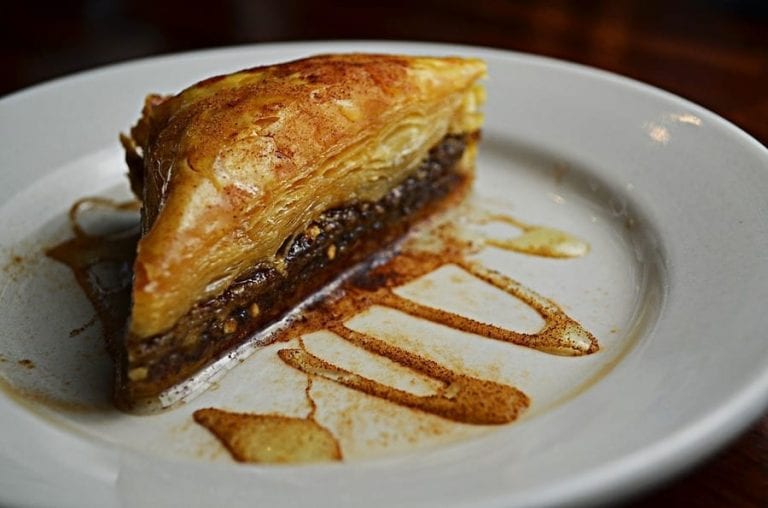
 US tariffs: here are the Italian wines most at risk, from Pinot Grigio to Chianti Classico
US tariffs: here are the Italian wines most at risk, from Pinot Grigio to Chianti Classico "With U.S. tariffs, buffalo mozzarella will cost almost double. We're ruined." The outburst of an Italian chef in Miami
"With U.S. tariffs, buffalo mozzarella will cost almost double. We're ruined." The outburst of an Italian chef in Miami "With US tariffs, extremely high risk for Italian wine: strike deals with buyers immediately to absorb extra costs." UIV’s proposal
"With US tariffs, extremely high risk for Italian wine: strike deals with buyers immediately to absorb extra costs." UIV’s proposal Meloni: "Tariffs? If necessary, there will be consequences. Heavy impact on agri-food sector"
Meloni: "Tariffs? If necessary, there will be consequences. Heavy impact on agri-food sector" The Government honours the greats of Italian cuisine, from Bottura to Pepe. Massari: "Thank you, Meloni, the only one who listened to us"
The Government honours the greats of Italian cuisine, from Bottura to Pepe. Massari: "Thank you, Meloni, the only one who listened to us"






